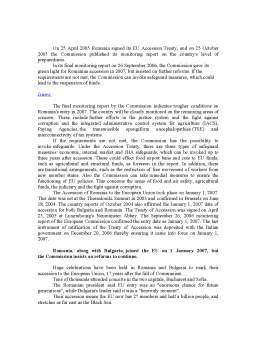Extras din referat
History of Romania since 1989
Since the Romanian Revolution of 1989, European Union (EU) membership has been the main goal of every Romanian Government and practically every political party in Romania. Romania signed its Europe Agreement in 1993[1] and submitted its official application for membership in the EU in 1995, the third of the post-Cold War Eastern European countries to do so after Hungary and Poland. Along with its official EU application, Romania submitted the “Snagov Declaration”, signed by all fourteen major political parties declaring their full support for EU membership.
During the 2000s, Romania implemented a number of reforms in order to prepare for EU accession, including the consolidation of its democratic systems, the institution of the rule of law, the acknowledgement of respect for human rights, the commitment to personal freedom of expression, and the implementation of a functioning free-market economy.
Short history of EU integration
Romania was the first Central and Eastern European country to have established official relations with the European Community. The bilateral agreement on Romania's inclusion in the EC's Generalised System of Preferences dates back to 1974, and another Agreement on Industrial Products was signed in 1980.
Romania established diplomatic ties with the European Union in 1990, and the following year a Trade and Co-operation Agreement was also signed. In 1995, the bilateral Europe Agreement entered into force.
Romania submitted its formal application for membership of the EU on 22 June 1995. However, the decision on the application came only at the Luxembourg European Council in December 1997. The Romania-EU intergovernmental conference meeting in Brussels on 15 February 2000 marked the official start of membership negotiations.
At the Copenhagen Summit in December 2002, EU leaders set 2007 as the target date for Romania to join the Union. "The 2007 entry goal is a realistic scenario," said former Enlargement Commissioner Günter Verheugen in June 2004. "Romania is in a decisive phase - it may be hard but it's possible."
In June 2004, the EU decided to set a new "safeguard clause" for Romania (and Bulgaria), which can delay accession by one year if the countries fail to meet their targets. Such delay would require a unanimous decision by the Council.
Meanwhile, in May 2004, Romania became a full member of the North Atlantic Treaty Organisation (NATO).
On 17 December 2004, the Brussels Council took note of Romania's progress in its accession preparations and considered that the country "will be able to assume all the obligations of membership at the envisaged time of its accession", ie January 2007.
On 22 February 2005, the Commission passed a positive judgement on the scheduled April 2005 signing of Romania's Accession Treaty.
In April 2005, the European Parliament gave its overwhelming support to Romania's EU bid. The vote was 497-93, with 71 abstentions. The second such report was issued on 16 May 2006.
On 25 April 2005 Romania signed its EU Accession Treaty, and on 25 October 2005 the Commission published its monitoring report on the country's level of preparedness.
In its final monitoring report on 26 September 2006, the Commission gave its green light for Romanian accession in 2007, but insisted on further reforms. If the requirements are not met, the Commission can invoke safeguard measures, which could lead to the suspension of funds.
Issues:
The final monitoring report by the Commission indicates tougher conditions on Romania's entry in 2007. The country will be closely monitored on the remaining areas of concern. These include further efforts in the justice system and the fight against corruption and the integrated administrative control system for agriculture (IACS), Paying Agencies, the transmissible spongiform encephalopathies (TSE) and interconnectivity of tax systems.
If the requirements are not met, the Commission has the possibility to invoke safeguards. Under the Accession Treaty, there are three types of safeguard measures: economic, internal market and JHA safeguards, which can be invoked up to three years after accession. These could effect food export bans and cuts to EU funds, such as agricultural and structural funds, as foreseen in the report. In addition, there are transitional arrangements, such as the restriction of free movement of workers from new member states. Also the Commission can take remedial measures to ensure the functioning of EU policies. This concerns the areas of food and air safety, agricultural funds, the judiciary and the fight against corruption.
The Accession of Romania to the European Union took place on January 1, 2007. This date was set at the Thessaloniki Summit in 2003 and confirmed in Brussels on June 18, 2004. The country reports of October 2004 also affirmed the January 1, 2007 date of accession for both Bulgaria and Romania. The Treaty of Accession was signed on April 25, 2005 at Luxembourg's Neumünster Abbey. The September 26, 2006 monitoring report of the European Commission confirmed the entry date as January 1, 2007. The last instrument of ratification of the Treaty of Accession was deposited with the Italian government on December 20, 2006 thereby ensuring it came into force on January 1, 2007.
Preview document
Conținut arhivă zip
- Romania in the European Union.doc




















